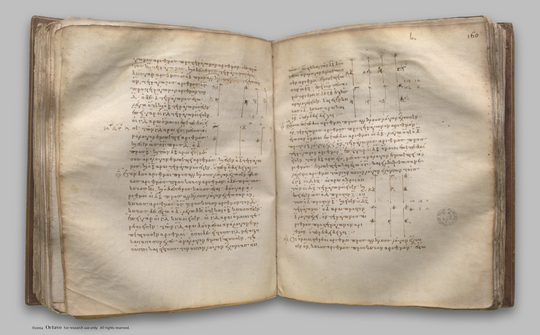index prev | digilib folio 164

Similar solid numbers have to one another the ratio which a cube number has to a cube number.
| Οἱ ὅμοιοι στερεοὶ ἀριθμοὶ πρὸς ἀλλήλους λόγον ἔχουσιν, ὃν κύβος ἀριθμὸς πρὸς κύβον ἀριθμόν. Ἔστωσαν ὅμοιοι στερεοὶ ἀριθμοὶ οἱ Α, Β: λέγω, ὅτι ὁ Α πρὸς τὸν Β λόγον ἔχει, ὃν κύβος ἀριθμὸς πρὸς κύβον ἀριθμόν. Ἐπεὶ γὰρ οἱ Α, Β ὅμοιοι στερεοί εἰσιν, τῶν Α, Β ἄρα δύο μέσοι ἀνάλογον ἐμπίπτουσιν ἀριθμοί. ἐμπιπτέτωσαν οἱ Γ, Δ, καὶ εἰλήφθωσαν ἐλάχιστοι ἀριθμοὶ τῶν τὸν αὐτὸν λόγον ἐχόντων τοῖς Α, Γ, Δ, Β ἴσοι αὐτοῖς τὸ πλῆθος οἱ Ε, Ζ, Η, Θ: οἱ ἄρα ἄκροι αὐτῶν οἱ Ε, Θ κύβοι εἰσίν. καί ἐστιν ὡς ὁ Ε πρὸς τὸν Θ, οὕτως ὁ Α πρὸς τὸν Β: καὶ ὁ Α ἄρα πρὸς τὸν Β λόγον ἔχει, ὃν κύβος ἀριθμὸς πρὸς κύβον ἀριθμόν: ὅπερ ἔδει δεῖξαι. | Similar solid numbers have to one another the ratio which a cube number has to a cube number. Let A, B be similar solid numbers; I say that A has to B the ratio which a cube number has to a cube number. For, since A, B are similar solid numbers, therefore two mean proportional numbers fall between A, B. [VIII. 19] Let C, D so fall, and let E, F, G, H, the least numbers of those which have the same ratio with A, C, D, B, and equal with them in multitude, be taken; [VII. 33 or VIII. 2] therefore the extremes of them E, H are cube. [VIII. 2, Por.] |